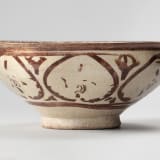


A lustre-painted bowl with dragons
The decoration of the well of this truncated, conical bowl is characterized by its vigorous and quickly applied decoration in concentric circles. In the central well, two lobed leaves filled with lustre-painted spirals and bisected by a single large dot-and-dash motif appear against a ground of further spirals and large dots of lustre paint. The central roundel is encircled by a primary border of rich chocolate lustre, with a calligraphic inscription incised through the lustre to the white glaze. The second concentric register contains a ‘scale’ motif that is punctuated four times by lustre-painted and incised confronted dragon-head motifs. The inclusion of the dragon motifs is a feature of Seljuq (r. in Iran c. 1040-1157) astrological iconography, which is often associated with the eclipse planet al-Jawzahr. The fearsome form of the dragon probably served an apotropaic function, and also has associations kingship and divine rule into the Ilkhanid Period (1256-1335), when this dish was made in the workshops of the Kashan potters.








